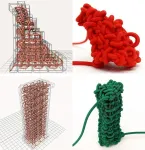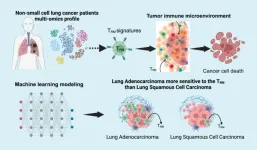(Press-News.org) HERSHEY, Pa. — Healthy blood vessels matter for more than just heart health. Vascular well-being is critical for brain health and potentially in addressing age-related cognitive decline and neurodegenerative disorders, like Alzheimer’s disease, according to new study led by Penn State researchers. The findings point to an understudied but possible key role the brain’s vascular network — or energy infrastructure — plays in the onset of neurodegenerative disease.
They published their work today (July 30) in Nature Communications.
Using advanced imaging techniques, the team developed maps of a mouse brain that illustrate how vascular cells and structures like blood vessels change with age and identified areas that are vulnerable to deterioration. When blood vessels degrade, nerve cells in the brain, called neurons, are starved of energy, causing them to malfunction or die. It can lead to a condition called vascular dementia, the second leading cause of cognitive impairment in older adults, and symptoms like sleep disturbance.
“With something like Alzheimer’s disease, by the time you can see vascular changes and significant brain shrinkage on a MRI, cell death has already occurred. We need to understand how these cells and structures change before a major catastrophe happens,” said Yongsoo Kim, associate professor of neural and behavioral sciences at Penn State College of Medicine and senior author of the study. “This study provides early signs of neurodegenerative disorders, potentially leading to earlier diagnosis, and clues for how we can slow down the aging process and cognitive changes.”
According to Kim, aging is one of the primary factors involved in neurodegenerative disorders.
“Yet, we really don't have a good baseline understanding of how normal aging itself changes the brain, particularly the brain’s vasculature,” Kim said. And with the aging population in the United States growing, he said it’s critical to understand these changes, especially within the network of blood vessels.
Blood vessels, especially micro-vessels, regulate oxygen and energy supply and waste removal to and from neurons. Despite their importance, Kim said, most existing research focuses on how neuron structure and function degenerates over time, rather than the vasculature. When researchers do study the brain’s vasculature, they’ve primarily examined larger blood vessels or focused on a single, easy-to-access region of the brain, the somatosensory cortex. More importantly, typical neuroimaging techniques, like MRI, don’t provide high enough resolution to see what’s happening in the tiny blood vessels, which make up 80% to 85% of the brain’s vasculature, according to Kim.
Kim and the research team produced a detailed map of the vascular network of the whole mouse brain using two high-resolution 3D mapping techniques: serial two-photon tomography — a technique that creates a series of stacked 2D images — and light sheet fluorescence microscopy, which images intact 3D samples to visualize the whole brain at a single cell-resolution. They imaged the brains of young and old mice to chart vasculature changes across the brain with normal aging.
“Because we're doing high-resolution mapping with the sufficient resolution, we can reconstruct the whole vascular structure and scan the entire brain to pinpoint areas that undergo selective degeneration with age,” Kim said. “What we found is that the area that most people study showed the least amount of change, whereas profound change happens in areas in the deep areas of the brain. This suggests that we’ve been looking at the wrong area when it comes to aging studies.”
The images showed that changes in the vascular network don’t occur equally across the brain. Rather, they were concentrated in the basal forebrain, deep cortical layers and hippocampal network, suggesting these areas are more vulnerable to vascular degeneration. These regions play a role in attention, sleep, memory processing and storage, among other functions.
As brains age, vascular length and branching density decreases approximately 10%, indicating that there’s a sparser network to distribute blood. Arteries in older brains also appear more twisted compared to those in younger brains, which can impede blood flow, especially to areas further away from the main arteries like the deep cortical layers, Kim explained.
The team also examined functional changes of vasculature and found that the system responds more slowly in older brains. That means that it can’t provide the neurons with energy as quickly and readily as the cells may need. There’s also a loss of pericytes, a type of cell that regulates blood supply and blood vessel permeability, too. As a result, the blood vessels become “leaky,” compromising the blood-brain barrier.
This study builds on the group’s previous research, where they mapped the vasculature of a young mouse brain. Next, they are studying how Alzheimer’s disease-induced changes in the brain influences vascular health and neuronal function. Ultimately, they said they hope their work will lead to treatments for neurodegenerative disorders.
Hannah Bennett, dual medical degree and doctoral degree student, and Steffy Manjila, postdoctoral scholar, co-led the study along with Quingguang Zhang, who was assistant research professor at Penn State at the time of the research and is currently assistant professor at Michigan State University, and Yuan-ting Wu, who was previously research scientist at Penn State and currently project scientist at Cedars-Sinai Medical Center. Other Penn State authors on the paper include: Patrick Drew, professor of engineering science and mechanics, of neurosurgery, of biology and of biomedical engineering and interim director of the Huck Institutes of the Life Sciences; Uree Chon, research technician; Donghui Shin, research technologist; Daniel Vanselow, research project manager; Hyun-Jae Pi, data scientist.
The National Institutes of Health and the American Heart Association funded this work.
END
New high-resolution 3D maps show how the brain’s blood vessels changes with age
Researchers identify mouse brain regions vulnerable to blood vessel degeneration, offering clues to the connection between vasculature and neurodegenerative disease
2024-07-30
ELSE PRESS RELEASES FROM THIS DATE:
Genes or environment? A new model for understanding disease risk factors
2024-07-30
HERSHEY, Pa. — Every disease is shaped by a genetic component as well as environmental factors like air pollution, climate and socioeconomic status. However, the extent to which genetics or environment plays a role in disease risk — and how much can be attributed to each — isn’t well understood. As such, the actions individuals can take to reduce their risk for disease aren’t often clear.
A team led by Penn State College of Medicine researchers found a way to tease apart genetic and ...
Study reveals impact of concern about misinformation on Americans’ media consumption habits
2024-07-30
Most Americans are aware of fake news and misinformation. In a new study, researchers from the University of Pennsylvania sought to uncover whether the threat of misinformation drives Americans to seek out news sources that reflect their own political beliefs.
The study, published in the Harvard Kennedy School Misinformation Review, found that Democrats, older individuals, and those with higher education levels are more concerned about misinformation in general and that, compared to Republicans, ...
USF students will swab first responder vehicles through a CDC-funded infection control initiative
2024-07-30
TAMPA, Fla. (July 30, 2024) – University of South Florida students are leading infection control training for fire and emergency medical services personnel as part of a groundbreaking initiative supported by a multi-million-dollar cooperative agreement with the Centers for Disease Control and Prevention.
This fall, student research and project assistants will begin swabbing first responder vehicles, ambulances, fire trucks and equipment to identify pathogen exposure risks and enhance training.
“By working on this aspect ...
Grainger Engineers to lead Illinois Quantum and Microelectronics Park, shape the future of quantum computing
2024-07-30
Today, The Grainger College of Engineering at the University of Illinois Urbana-Champaign joined other partners from around the state in officially announcing its leadership role in the Illinois Quantum and Microelectronics Park. The project – a quantum-focused research and development campus in Chicago – will be managed by a University of Illinois-led organization on behalf of the State of Illinois and Governor J.B. Pritzker.
Advances in quantum information science and engineering, together with next generation microelectronics, promise to transform computing, which underpins much of how our modern society operates. Grainger Engineering Associate Dean for Research ...
Research warns of “systematic weaknesses in jury decisions”
2024-07-30
There are “systemic weaknesses” in the way juries make decisions – and these are likely to be contributing to the conviction of innocent people, failures to convict the guilty, and inequalities, new research warns.
The current legal rules involving procedure and evidence are not consistently designed based on robust evidence about how the juries make decisions, but the system could function better, according to a new book.
Dr Rebecca Helm, from the University of Exeter, outlines how juries are likely to struggle to make effective legal decisions in predictable case types, including cases involving sexual offences in which testimony ...
NYU Tandon School of Engineering and Indian Institute of Technology Kanpur announce seven joint research projects launching their new partnership
2024-07-30
NYU Tandon School of Engineering and Indian Institute of Technology Kanpur (IIT Kanpur) have unveiled their inaugural roster of collaborative research projects, the first such initiatives under the broad partnership that NYU and IIT Kanpur established last year.
The seven projects, jointly led by researchers from each institution, aim to advance innovations across vital scientific fields including cybersecurity, biotechnology, artificial intelligence, robotics, and wireless communications.
NYU and IIT Kanpur announced their initial partnership agreement in September 2023, ...
Study finds genetic variant among people who experience a rare recovery from ALS
2024-07-30
DURHAM, N.C. – Though exceedingly rare, some people diagnosed with amyotrophic lateral sclerosis (ALS) partially or fully recover from the lethal neurodegenerative disease.
A better understanding of this baffling phenomenon, reported in medical literature for at least 60 years, could point to potential new treatment approaches. To that end, researchers at Duke Health and St. Jude’s Research Hospital launched a study of ALS recovery patients and found certain genetic factors that appear to protect ...
Watch ut IKEA: CMU Researchers eye knitted furniture
2024-07-30
Yuichi Hirose has a dream — a dream that someday everyone will have access to a machine capable of knitting furniture.
This machine wouldn't just knit the furniture's exterior fabric, but would use knitting to fashion solid three-dimensional chairs, tables and other objects. Tired of that love seat? Just unravel it and reuse the yarn to knit yourself an ottoman.
This new fabrication technique — first envisioned by Hirose, a robotics Ph.D. student in Carnegie Mellon University's School of Computer Science — is called solid knitting. The idea captured his imagination more than a decade ago. And now, working with a research team headed by James ...
Enjoy your work? Don’t sell yourself short. Buyers are willing to pay more for products you enjoy producing
2024-07-30
Researchers from Tilburg University, Northwestern University, and Lehigh University published a new Journal of Marketing study that examines how a seller’s enjoyment in making a product influences buyers’ willingness to pay and the price the seller charges.
The study, forthcoming in the Journal of Marketing, is titled “Production Enjoyment Asymmetrically Impacts Buyers’ Willingness to Pay and Sellers’ Willingness to Charge” and is authored ...
Recent study reveals key immune cells as critical factors in lung cancer prognosis
2024-07-30
(LOS ANGELES, July 30, 2024) – An extensive analytical study performed at the Terasaki Institute and published in Frontiers in Immunology highlights the crucial role of tissue-resident memory T cells and how they influence the immune environment of patients with non-small cell lung cancer and their overall prognosis.
Non-small cell lung cancer accounts for ~85% of lung tumors and is a leading cause of death in adults. Tissue-resident memory T cells, a specialized subset of immune cells residing in peripheral tissues, have been ...
LAST 30 PRESS RELEASES:
Exposure to natural light improves metabolic health
As we age, immune cells protect the spinal cord
New expert guidance urges caution before surgery for patients with treatment-resistant constipation
Solar hydrogen can now be produced efficiently without the scarce metal platinum
Sleeping in on weekends may help boost teens’ mental health
Study: Teens use cellphones for an hour a day at school
After more than two years of war, Palestinian children are hungry, denied education and “like the living dead”
The untold story of life with Prader-Willi syndrome - according to the siblings who live it
How the parasite that ‘gave up sex’ found more hosts – and why its victory won’t last
When is it time to jump? The boiling frog problem of AI use in physics education
Twitter data reveals partisan divide in understanding why pollen season's getting worse
AI is quick but risky for updating old software
Revolutionizing biosecurity: new multi-omics framework to transform invasive species management
From ancient herb to modern medicine: new review unveils the multi-targeted healing potential of Borago officinalis
Building a global scientific community: Biological Diversity Journal announces dual recruitment of Editorial Board and Youth Editorial Board members
Microbes that break down antibiotics help protect ecosystems under drug pollution
Smart biochar that remembers pollutants offers a new way to clean water and recycle biomass
Rice genes matter more than domestication in shaping plant microbiomes
Ticking time bomb: Some farmers report as many as 70 tick encounters over a 6-month period
Turning garden and crop waste into plastics
Scientists discover ‘platypus galaxies’ in the early universe
Seeing thyroid cancer in a new light: when AI meets label-free imaging in the operating room
Neutrophil-to-lymphocyte ratio may aid risk stratification in depressive disorder
2026 Seismological Society of America Annual Meeting
AI-powered ECG analysis offers promising path for early detection of chronic obstructive pulmonary disease, says Mount Sinai researchers
GIMM uncovers flaws in lab-grown heart cells and paves the way for improved treatments
Cracking the evolutionary code of sleep
Medications could help the aging brain cope with surgery, memory impairment
Back pain linked to worse sleep years later in men over 65, according to study
CDC urges ‘shared decision-making’ on some childhood vaccines; many unclear about what that means
[Press-News.org] New high-resolution 3D maps show how the brain’s blood vessels changes with ageResearchers identify mouse brain regions vulnerable to blood vessel degeneration, offering clues to the connection between vasculature and neurodegenerative disease



